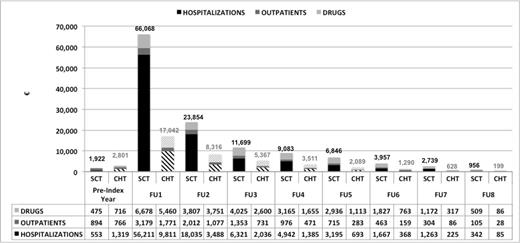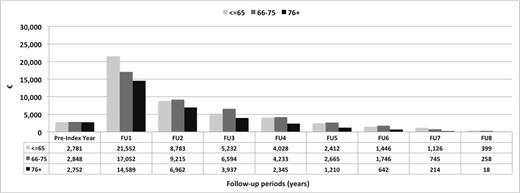Abstract
Introduction. In the last 15 years, stem cell transplantation and novel agents have increased the remission rates and improved survival in multiple myeloma (MM) but they have also affected the cost of myeloma treatment. The aim of the present study was to describe direct healthcare costs in treating MM patients from a 2003-2009 population-based study.
Methods. Since 2000the Regional Health Service (RHS) of Lombardy, covering around 10 million people, systematically organizes its healthcare administrative archives into a data warehouse named DENALI. A distinguishing feature of DENALI is the probabilistic reconstruction of links to match the data of different datasets belonging to the same person. The study population of the present study was selected from DENALI and involved all those individuals who during the period 2003-2009 had at least one hospital discharge for MM and at least one MM specific drug prescription among melphalan, bortezomib, cyclophosphamide, thalidomide, doxorubicin, and lenalidomide. The index date was identified by the first hospital discharge or drug prescription whichever occurred first. From the initial population we excluded individuals with a diagnosis of cancer prior to the index date to avoid overlapping oncological diagnoses, and also those who did not receive chemotherapy (CHT) to focus on patients with symptomatic MM. The period of observation ended at 31-Dec-2010. The study period was divided in one year before the index event (given by 365 days before the index date) and 8 follow-up (FU) years (ranging from 1 to 8 years after the index date, the latter included in the first follow-up year). We estimated healthcare costs (hospitalizations, drugs and outpatient examinations/visits) per patient per year from the RHSÕs perspective. Costs were expressed in euro.
Results.
During the study period, a total of 3,043 eligible subjects (52% male) experienced at least one hospital admission for MM and one prescription of MM specific drug, corresponding to 4.6 cases on 100,000 Lombardy inhabitants per year. Subjects had a median (min-max) age of 68.6 (17.5-96.8) years.
Patient who had a Stem Cell Transplantation (SCT) represented 30% of the study population: within this group 90% had one or more Autologous Stem Cell Transplantation (ASCT), 1.5% had one or more Allogenic Stem Cell Transplantation and the remaining 8.4% had both.
The average cost for a treated MM patient during the 8 years of study period was 64,816 (95% I.C. 62,628-67,003). In the year of index (FU1) the average cost was 31,945 (95% I.C. 30,776-33,113): 75% represented by hospitalizations, 18% by drug prescriptions and 7% by outpatients.
A patient who had at least one SCT reported an average cost of 125,202 (120,777-129,628) during the entire follow-up period: 66,068 (63,820-68,314) in the year of index with a distribution by type of cost of 85%,10%, and 5% represented by hospitalizations, drug prescriptions and outpatients, respectively.
Accordingly, patients treated with only pharmacological treatment (CHT) had a 8 years average cost equal to 38,433 (37,097-39,788): 17,042 (16,477-17,606) during the year of index with hospitalizations as the main cost driver (58%), followed by drug prescriptions (32%) and outpatients (10%).
The distribution of the average cost by year of observation and cost type was shown in Figure 1.
Within the SCT patients who had one ore more ASCT the mean cost was 114,661 (110,801-118,521) in the year of index (FU1) while for those who had one or more allogenic SCT the mean cost was 171,779 (132,925-210,634).
During the year of index those CHT patients older than 76 years had a mean cost equal to 14,589 (13,794-15,384) significantly (p<1%) lower than the one estimated for younger patients during the same year (FU1): in particular 21,552 (19,744-23,359) and 17,052 (16,117-17,985) were the mean costs for CHT patients younger than 65 years and aged between 66 and 75 years, respectively. This result was also observed in FU2-FU6 (Figure 2).
Conclusions. MM is a burdensome condition with relatively high costs mainly driven by hospitalizations and drugs. A real-world picture of MM treatment costs is needed for health care providers and policy makers in order for understanding and making decisions about resource allocation for MM treatment.
Mean cost (euro) for SCT and CHT patient by type of cost and year of observation
Mean cost (euro) for SCT and CHT patient by type of cost and year of observation
Mean cost (euro) for CHT patients by age class and year of observation
Rossi:Janssen: Consultancy. Mantovani:Janssen : Research Funding.
Author notes
Asterisk with author names denotes non-ASH members.



This feature is available to Subscribers Only
Sign In or Create an Account Close Modal